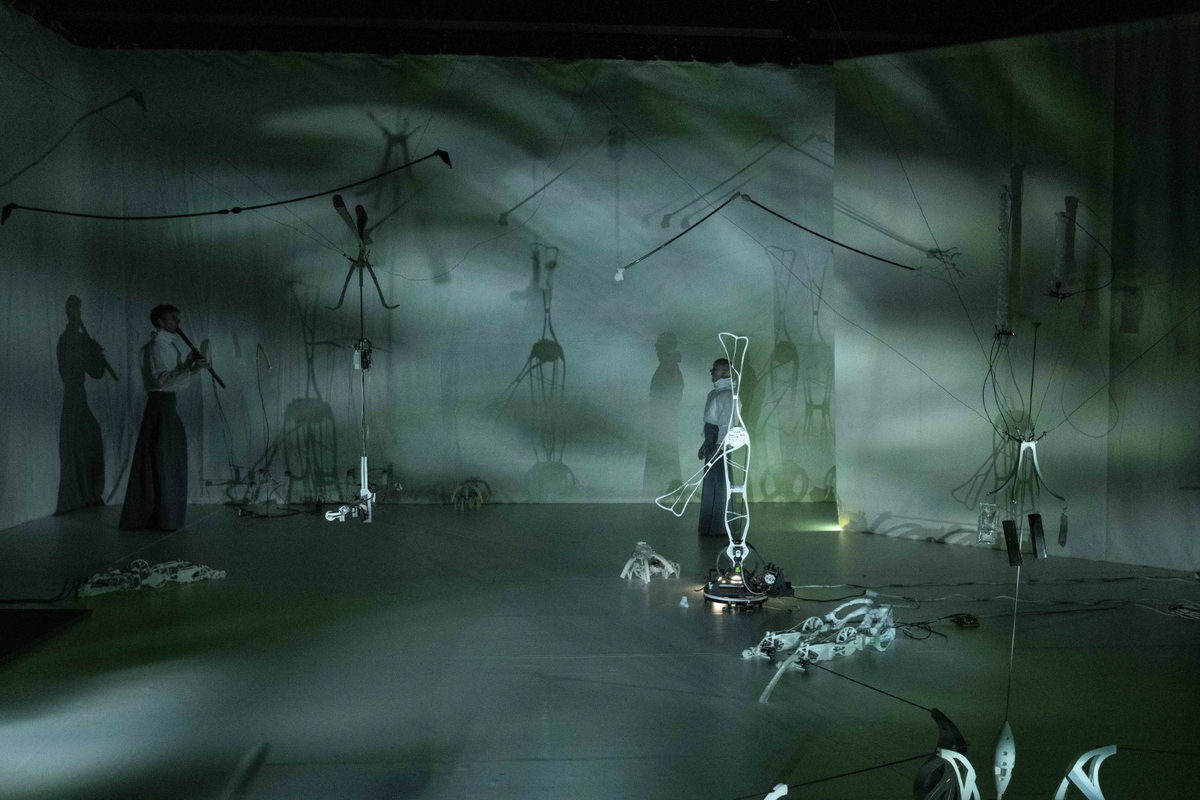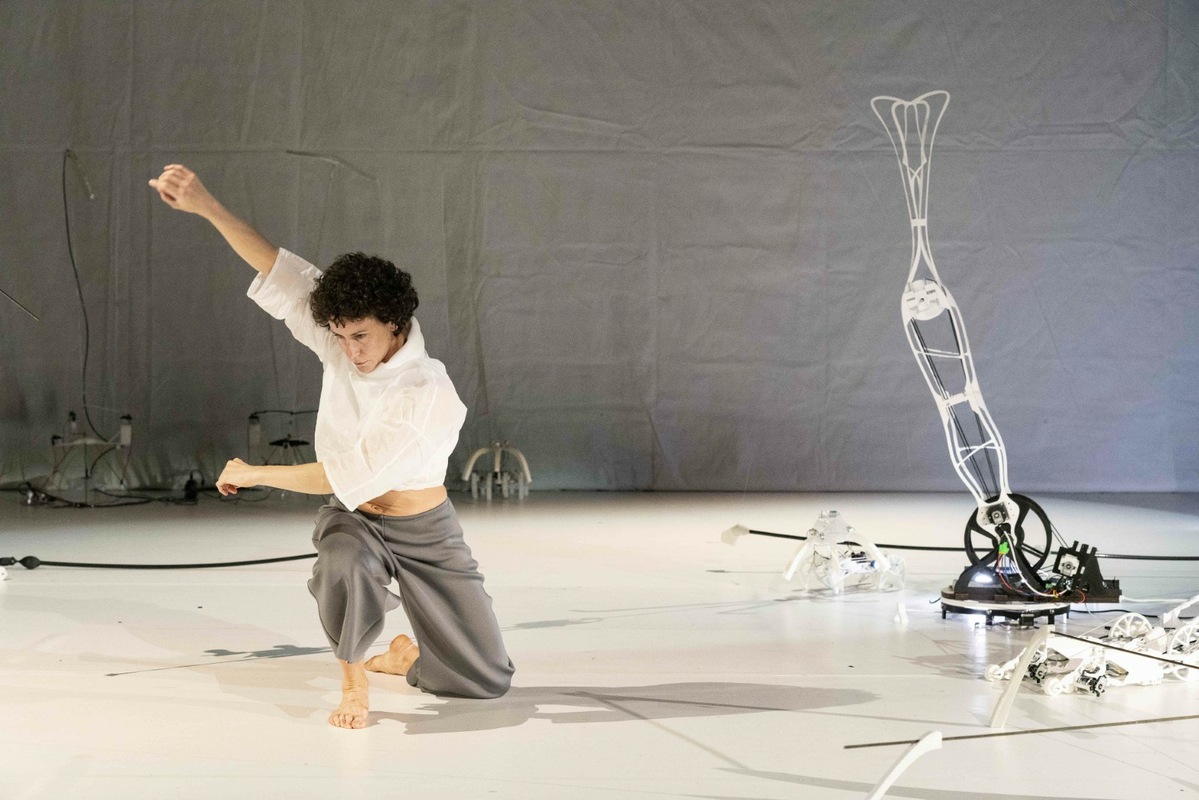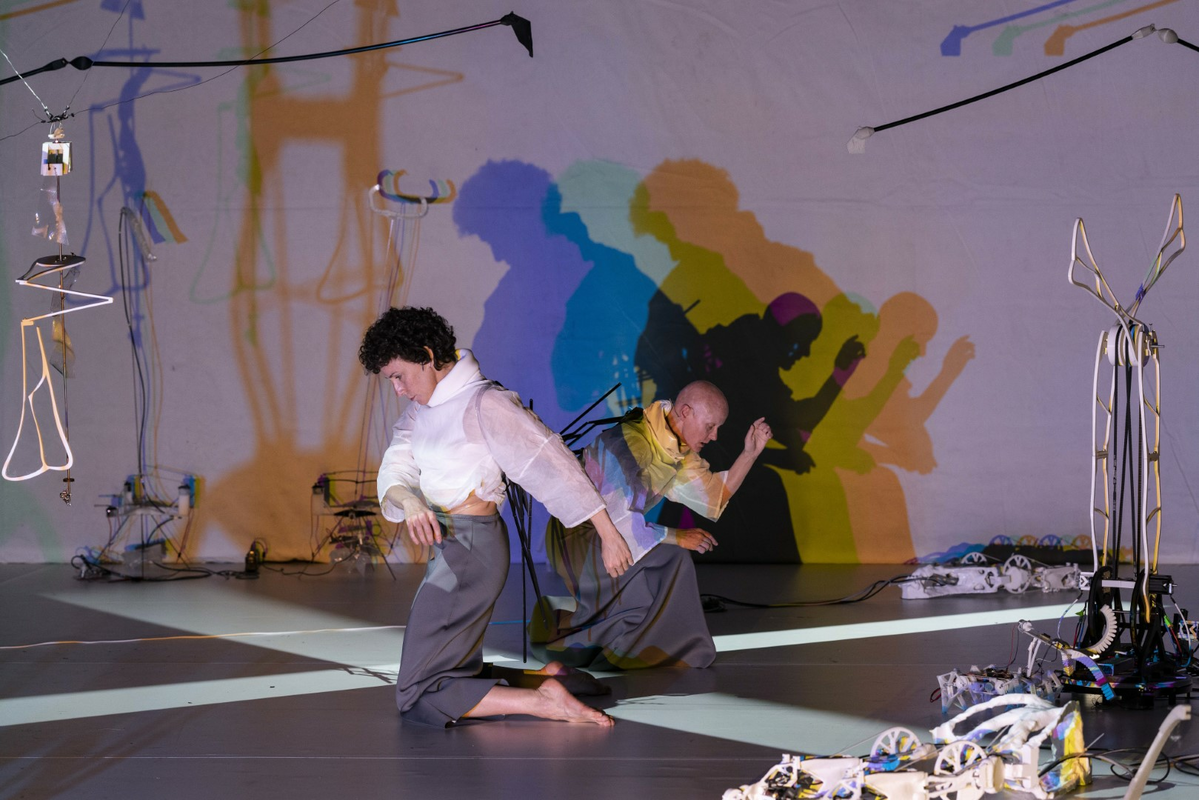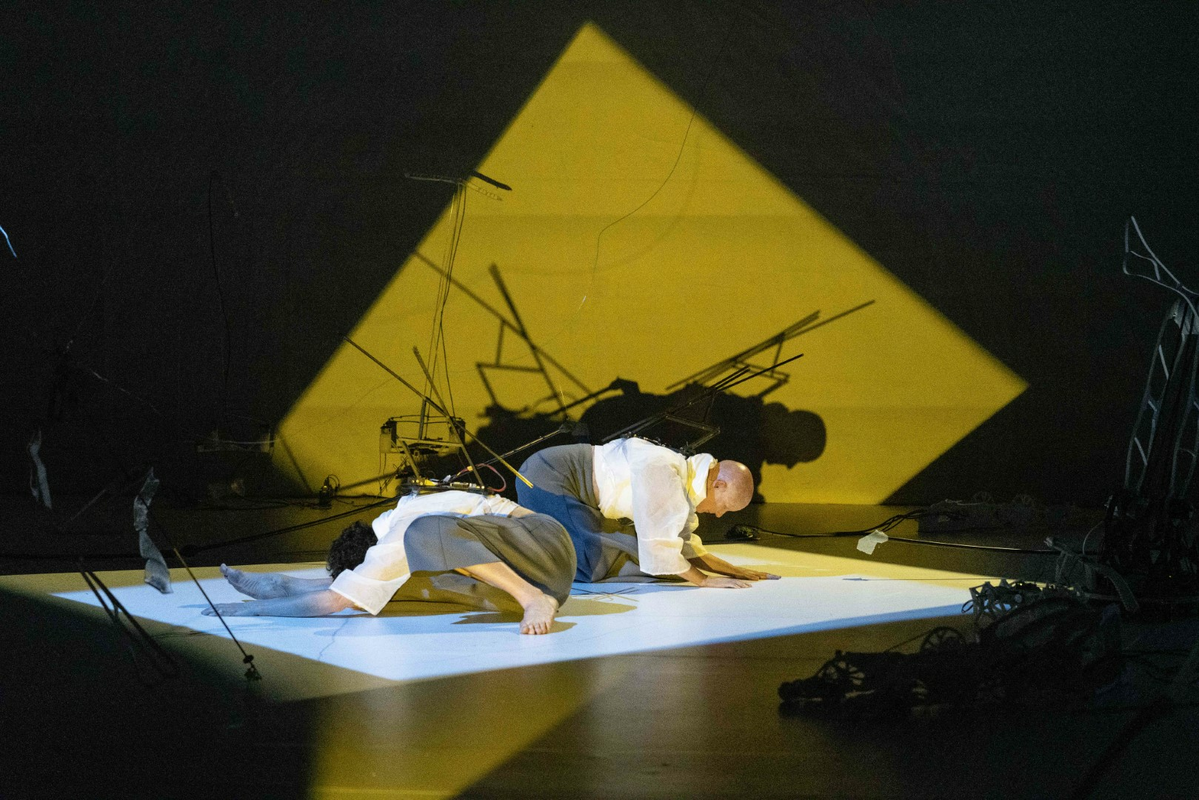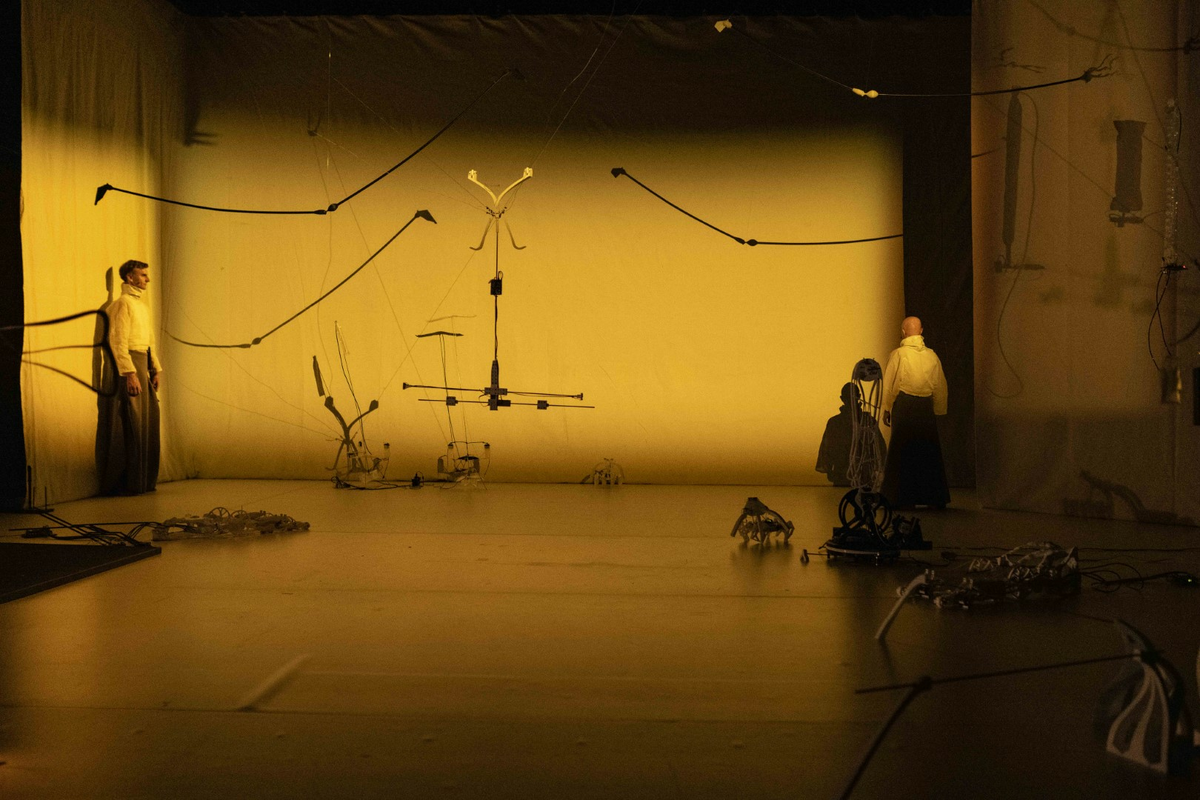For one - for many - for all
Performed at Cornerteateret
Bergen, Norway 18 - 20.06.2021
The artistic research project Emotional machines – composing for unstable media concludes with two complementary public artistic presentations taking place in bergen in June 2021; a time based stage production presented by BIT Teatergarasjen at Cornerteatret and a gallery exhibition presented by and at Lydgalleriet. The presentations are considered connected and have the common title For one – for many – for all.
With
15 kinetic figures
Performers: Alwynne Pritchard, Caroline Eckly, Jostein Gundersen
Musical and movement material performed by humans have been developed with the performers
Kinetic figures/composition/sound design/choreography/system development: Thorolf Thuestad
Lights: Silje Grimstad
Custumes: Maria Victoria Høvring Høeg
Producer: Aistė Žumbakytė
Construction assistance/talks: Roar Sletteland
I thank all part-takers for their immense creative force in developing For one- for many - for all
Supervisors: Trond Lossius og Juliana Hodkinson
Technical producer: M12 Kultur
Co-producers: The University of Bergen, BIT Teatergarasjen, Lydgalleriet and M12 Kultur
Stage technicians: Snorre Rønning Mandal, Runar Gåserud
Supported by: The University of Bergen, The Norwegian Artistic Research Programme(NARP), Arts Council Norway, Bergen Kommune and The Norwegian Society of Composers.
For one - for many - for all is part of Thorolf Thuestads Ph.D. in artistic research at The Grieg Academy, Department of music, The University of Bergen.
Updated and higher resolution documentation available at: https://vimeo.com/572261484
Video photage by Ben Speck, Ronald Toppe and Odd Inge Tveterås Eliassen.
Photos: Thor Brødreskift
What is done by not doing.
Jostein Gundersen on being part of For one – for many – for all.
«For one - for many - for all» was a new experience for me. My first substantial encounter with kinetic sculptures was in «For one - for many» at Østre in 2019. Already then I was fascinated by the sculptures and my immediate and unescapable assimilation of their movements and shapes with that of humans and animals - a feeling a bit like the impossibility of unlearning how to read. This fascination I felt already when seeing the sculptures, independently of me performing with them. As a performer, I was delighted to find myself in a completely new situation, somewhere between that of being a sculpture, a machine or robot, and a human being. I was fascinated by the tension of moving in a field between contained human being and sculpture. When one moves, one questions the will of the person. When one does not move, it is clear that at some point, movement will have to happen. There is too much and too little will in all the participants.
Not moving with intent
In «For one - for many - for all» I was for large parts of the time completely still, like a sculpture. You asked me during the preparations if I was OK with that. I don’t remember your exact wording, but I perceived it to be a concern whether I would like to be «activated» more, maybe because Caroline and Alwynne were moving more than I. I found your question very sympathetic and considerate. I was, however, not worried about not moving more. I found it satisfying to feel that I could be expressive without doing anything, by merely being a body in the room. And as I had already discovered, I was not doing nothing. I spent a lot of concentration on not moving, since the tiniest movement is noticeable in a still body. There is clearly a difference between idleness of the mind, which in my case would lead to a lot of small body-movements, and stillness of the body, which signifies a strong intention of the mind. Although it the performance had elements of subjugation and something being contained, I found it satisfying and to some extent deliberating to discover that I could be expressive and contributing to the tension of the performance in this way, by just being my own body.
The difficulty of the performance was clearly to be non-inventive and think at the same time. To walk in slow motion whilst thinking about which sound to play next was more difficult than I expected. It was also a challenge to me to play for several minutes without any kind of development. The non-expressive mode also made it difficult to hide small flaws in my playing, that to clearly display a human at work: intonation issues, missed notes, too little air at the end of the phrase…. If I were to point out one thing that I was not happy with, it would be a couple of missed notes in the last sequence facing the wall. Such moments can completely break the spell, which I hope it didn’t do.
From within
Roar Sletteland on being part of For one – for many – for all
I had two roles in this project: one discursive and one technical. In the early stages of the research, I was summoned as a conversation partner, to address certain issues: anthropomorphism, art, animate and inanimate objects and such. During our discussions, we may or may not have developed a better understanding of the things Thorolf wanted to explore. It is hard to tell. It was fun, anyway.
Toward the end of the period, I was invited to assemble some of the mechanical devices that Thorolf had developed during his fellowship, create viable technical solutions, make sure the large number of cables, power supplies, motors, controller units, batteries, all were designed and connected in a safe and stable way, if not to make the objects come alive, at least to make sure they would stay alive during the critical phases of their existence, that is, during the time they were presented for an audience. The laborious and time-consuming task of making things work, however important, all the same quotidian and repetitive.
Seemingly, my involvement would follow a traditional dividing line, between theory and practice, talking and doing, the work of the mind as opposed to the hand, the critic or academic as opposed to the artist, commenting as opposed to creating, with the slight deviation that I would jump from one side to the other during the process. However, the division was not so clear when looked at more closely. For one, discussing the project is part of the creative process, not just a comment on it. Soldering cables and scraping debris off mechanical parts, on the other hand, is in general not considered part of the artistic process. In fact, in most artistic work of a certain complexity, like stage work and film, there is a substantial number of people involved whose contribution isn’t mentioned or noticed or considered relevant for the artistic output. Unlike, for instance, light designers, scenographers and performers, these people are often nameless and voiceless, interchangeable, non-expressive. Stagehands, tech staff, various types of managers and producers, working silently in the background, like cogs in a machinery. Which is something to be considered, perhaps, in a project that explicitly concerns the agency of machinery. These people are not involved in the artistic process as such, just accommodating it, handling it from a distance, so to speak.
In a sense, my technical contribution was more like that, myopically focusing on the electronics and the mechanics, not too concerned with the end result, or even the aesthetics involved. In fact, even the early conversations were quite general, circling around questions of epistemology, science and representation, belief and disbelief, art and language, and less about artistic choices. Unlike most of the crew involved, I wasn’t working towards the final performance and exhibition, but locally on each object, trying to make them as stable as possible. This position, in a way exempt from artistic responsibility while still committed to the stakes, I found very interesting – at the same time involved and detached, simultaneously working and observing.
I remember watching an interview with Sidney Pollack, who claimed that «directing is like sex. You never get to see how the others do it». His point was that since he also was an actor, he could observe the other directors at work. The director in question was Stanley Kubrick, and the film was his final masterpiece Eyes Wide Shut, a film obsessed with looking (and sex, incidentally), about secrets in plain sight, about the incongruence between language and image, where the words fall flat to the ground, followed by embarrassing silence – a film in which Pollack had a small, but significant part. The remark was probably not very serious, but the message is profound enough – that watching and doing are two very different activities, sometimes mutually exclusive, and never something that simply happens. In order to observe, one must be in a position to observe, and in order to do, one must be in another position.
Remember: the words theatre and theory have a common origin. They derive from the Greek theoros, which was the name given to a visitor, coming to observe the holy rituals. Coming from the outside, being on the outside, enabled him to behold the ritual as a spectacle unfolding before him. Hence theory, hence theatre. Observation requires distance and non-engagement. This distance, this position where theory can occur, is also the position of the audience. What position is this? Firstly, it is a privileged position, where the onlooker, standing on the outside, is able to pass judgement on whatever lies in front. It is the position from where one can state the truth about the object: “this is good”, “this is successful”, “this is art”. So it also requires an object, a spectacle, something to pass judgement on. Even if it is a superior position, the viewer is also dependent, in need of something to look at, and also locked to this specific relationship, like Ulysses tied to the mast. A limited power indeed.
And then, there is the fact that the audience is not really stating the truth about what is unfolding before them – rather, they are being tricked, seeing only what the artist wants them to see. Only after submitting to this ruse can they perform the judgement. A kind of agreement or pact between the work and the onlooker – suspension of disbelief is perhaps the right expression – where blots of paint become persons, sequences of images become narratives, people represent other people – and these strange, moving plastic things turn into unfathomable living beings. I feel they have intentions, but know they do not have it. In order for the play of anthropomorphism to come into being, a specific relationship between work and viewer – a certain distance, a great deal of good faith – must be installed. Only then will these creatures come to life.
The funny thing is, that what makes these things appear human – to me, anyway – is their vulnerability, their faults and generally non-impressive behaviour, and the very real risk of failure. Sometimes some of them would become too impressive, too elegant, and then it becomes just a robot. Unlike human performers, these objects seem human when they don’t represent, when they are only themselves. When they are not trying to put up a show. Or, when they engage in social situations, interacting with each other or with humans. Then, a certain agency seems to appear.
What I found interesting, was that the real magic happened during the process of trying to make these objects work, not in the performances. The perpetual care they needed, the constant adjusting and tweaking, endless repairs and reboots, made their coming-to-life seem like a real struggle. Of course, it was mostly Thorolf’s struggle, but in some strange way, it seemed like they wanted it themselves.
Maybe it was because of the inherent teleology in these creatures: they had one goal, and the pleasure of seeing them reach it, created an illusion of will. Maybe it was being constantly on the critical dividing line between living and non-living, to watch them cross that line, back and forth, again and again. Or maybe it simply was the interaction, slowly getting to know them, their strength and weaknesses, seeing their personality gradually taking shape. Whereas the performance and the exhibition present something that is already achieved – the objects’ ability to move and interact. Of course, this movement would also be imperfect, human-like, including glitches and squeaks, but it would still be relatively controlled, like a well made representation of something not so well made.
In that sense, I felt that my own position was a privileged one. Like Sidney Pollack, I got to have it both ways, to see the project from the inside and the outside, to have the observer’s perspective on the process, while at the same time a part of that process. For that I remain grateful.
One day during the production process, a bird died in the large hall where we were working. Maybe it was dying already and sought a quiet place, or maybe it crashed into one of the many cables hanging from the ceiling. In any case, it died and I buried it under a bush outside the building. I’m not very knowledgeable about birds, but it was a tiny one – some kind of sparrow, I suppose. It had been flying around in the ceiling for a few hours, sometimes coming down. I thought it acted a bit strange – for instance, it didn’t seem afraid of me, just unwilling to go through the doors and windows that I opened. At some point it landed on the mat among the objects. It just sat there, looking confused. A few times, it walked a bit around, but most of the time it sat still. It seemed alive, and it was alive. And then it wasn’t.
Relations
Caroline Eckly on being part of For one – for many – for all
The collaboration between different art fields is something I really believe in and the piece is the perfect example of how installation, music, lighting and performance can contribute to create a whole experience.
When Thorolf first presented his project to me, he showed an animation movie made in the 40’s by two psychologists with simple geometrical figures in movement and he asked me what I saw in it. The movie supports the theory that any human-being would automatically create their own relational narrative and connection with the figures in the movie. I believe that this free associative capacity is something Thorolf wants to trigger by putting performers next to his kinesthetic figures on stage. This idea that any audience member can have its own interpretation is very present when using abstract movement as a medium in a performance. As a dancer, I had to question my relation to the mechanic figures, how precise should and can I be, knowing that my humanity stays very obvious in confronting them? But also how precise and systematic can those figures be and how much I can rely on them?
It was fascinating how my associations with the different figures would change with time or according to the day or light, how I could see a building site, a retro-futuristic city or a transforming fantastic fauna: birds, insects, aquatic creatures.
Light, dark and frame
Silje Grimstad on being part of For one – for many – for all
Lighting in a theatre is forcing a perspective to a object or a room. I found it very inspirational to give the objects a personality, and also dehumanize the humans, working with what they have in common. The lamps in use are also stationary kinetic objects in the outskirts of the performance, not far from the objects on stage. Moving in the space. With fine-tuned optics. Zooming in and out. Giving focus and removing it.
I really enjoyed being able to work freely under inspiration. The use of shadows copies the objects on stage, giving us an illusion that there are more of their kind. I especially enjoyed working with color theorem and sharp focused light sources blending, creating shadows and contrasts.
Process
Jostein Gundersen on the process of developing For one – for many – for all.
I have been impressed by your thorough ethical considerations. Firstly, you have had a very serious attitude to health and security (including restrictions following the pandemic), rehearsal hours and general comfort. Secondly, you have had an artistic transparency and methodology that I have greatly appreciated, and that I have used as example in several of my presentations about ethics in artistic research. I will try to give a short account of my experience:
Already when inviting me to participate in 2019, you were clear about your interest in my physical appearance. The analogies between the sculptures and my tall and slim body, as well as between the hydraulic systems and me playing a wind instrument, was as important to you as my flute playing in itself. I am not sure that every artist would understand the importance of this clarification, but I value it very much. Any participant comes with a wealth of competencies. If nothing is said, the default expectation will probably be that one will contribute with what one knows best, in my case flute playing. Discovering at a late point that it is as much about the way one looks (or any other quality which one has not spent years training) might be disappointing and frustrating. You articulated your ambitions before the first rehearsal, with clear thoughts about the kind of activity and the kind of appearance you were envisioning. That allowed me to make an informed choice about my participation before the process started.
Your rehearsal working method, which I would describe as a directed search, gave me a feeling of control and agency over my own body and playing. You credited my efforts were whilst leaving aside sounds and movements that did not suit the performance, without any feelings of censorship or refusal. You frequently paid attention to physical and musical qualities you liked, even after they had been long established, and even something as obvious as being able to stand still. That was encouraging.
You have also been clear about how much time you want me to invest. You have asked me to meet difficult scores with a level of pragmatism and creativity, where your main ideas are intact but the details of performance open to negotiation. That has allowed me to find solutions where my skills come to use in a way that fits the overall aesthetics of your soundscapes. You have welcomed questions and opinions throughout the process, and obviously taken them into consideration. Altogether this has resulted in a project where I have felt like a creative artist more than an «executer» of directions, which, when seen from a distance, might be a surprise to some, considering that I spent much of the show standing motionless on the side of the stage.
Fabric
Maria Victoria Høvring Høeg on being part of For one – for many – for all
The costumes in «For one - for many - for all» consists of latex, wetsuit material (neoprene), plastic (PVC) and lining (cotton organza) which is often used for wedding dresses. Originally the sleeves where designed to have light diodes inside, which didn’t make it to the stage this time. For me it was important to choose materials that would complement the stage and the kinetic figures. To me, all the kinetic figures are different, but still many elements are repeated, which I tried to do as well with the costumes. The human performers should not take over the stage, or be taken over by the figures, but co-exist. My main intention with the costumes was to allow this.
Early on in working on this project, I learned and experienced trust from Thorolf. As a participant in the project, I felt that the trust was really important. Thorolf would sometimes comment and give feedback, but most of the time, I felt that I could make choices and be trusted in by doing so – this is a really valuable and important attitude to bring forward, the trust to the ones you work with – especially in a new working situation.
In many projects for the stage, the different participants are not included or mentioned in the promotion, but in Thorolf’s promotion for the project, a lot of the people behind were mentioned and promoted.
I think, to both be seen and to be trusted in a working situation, makes me want to walk the extra mile, and to invest more. To always be friendly but also to be clear, to have trust and to see the ones you work with, is qualities that I want to bring with me, and which inspires me. I am very thankful for the whole experience.
The tribe
Alwynne Pritchard on being part of For one – for many – for all
For me, the process of working on For One - For Many - For All was something that began two years or more before the first rehearsal. Living in the same house as Thorolf, watching the figures being made and seeing them develop, meant that they were very familiar to me by the time rehearsals started. I had also worked with a version of one of the figures in 2020, in the piece Nether which Thorolf created for my solo DOG/GOD II project, and provided the voice for another, as part of an artistic research presentation. So, in a way, they had become friends, each with characteristics that I had become familiar with, however strange they seemed at first. And even having seen the figures when they were nothing more than filament on its way to the 3D printer, or as parts on the floor of Thorolf’s studio, it was still impossible not to imbue them with character when they were complete, or at a stage where their form resonated with my own human experience of physicality and movement. Half-finished figures that don’t move (or can only partially move or be controlled) still have a presence as personalities. Over time, I found that my feelings towards them grew to be one of affection and my perception of them was as grotesque but also often comical abstractions of human characteristics that I empathise with very much.
Seeing them all together for the first time, though, my experience of them was different. They felt more like members of a species or genus - or even a tribe. They also often behaved erratically, sometimes even dangerously during the earlier rehearsals, which made them feel threatening and my relationship with them more cautious - sometimes even antagonistic. I was watchful and wary. As the piece progressed and our tasks became clearer and more demanding, I became less aware of the figures, other than when I had to relate to them directly. My visual focus was generally concentrated either directly in front of me and towards the floor, so I could often hear things happening that I could not see. That was interesting and also sometimes made me feel uneasy. But this unease rhymed with something aggressive that I feel to be present in the figures, and that is a useful and fruitful resource for me as a performer. Although the figures created a world that was not always easy to access for me, I found the experience of trying to focus and channel the physical tension they embody and express, fascinating. My own internal body clock runs fast and I have a lot of energy that I like expend quickly whenever I can. In this company, in the universe created by the figures, the tempo and dynamic range is much more contained, while also being hard to predict with precision and, like walking on the moon, my performance had to adapt to the physics of the environment.


